The Samsung 850 EVO 4TB SSD Review
by Billy Tallis on July 11, 2016 10:00 AM ESTAnandTech Storage Bench - The Destroyer
The Destroyer is an extremely long test replicating the access patterns of very IO-intensive desktop usage. A detailed breakdown can be found in this article. Like real-world usage and unlike our Iometer tests, the drives do get the occasional break that allows for some background garbage collection and flushing caches, but those idle times are limited to 25ms so that it doesn't take all week to run the test.
We quantify performance on this test by reporting the drive's average data throughput, a few data points about its latency, and the total energy used by the drive over the course of the test.
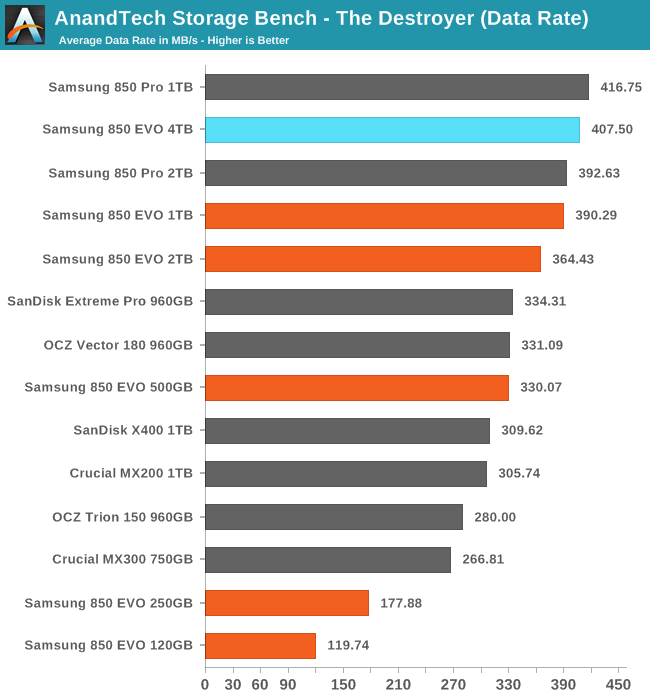
The Destroyer isn't enough to really challenge the 4TB 850 EVO, as this test doesn't write enough data to fill the drive even halfway. The 1TB 850 Pro still holds the record for the highest average data rate maintained by a SATA drive, but the 4TB EVO is closer to that than to any slower drive.
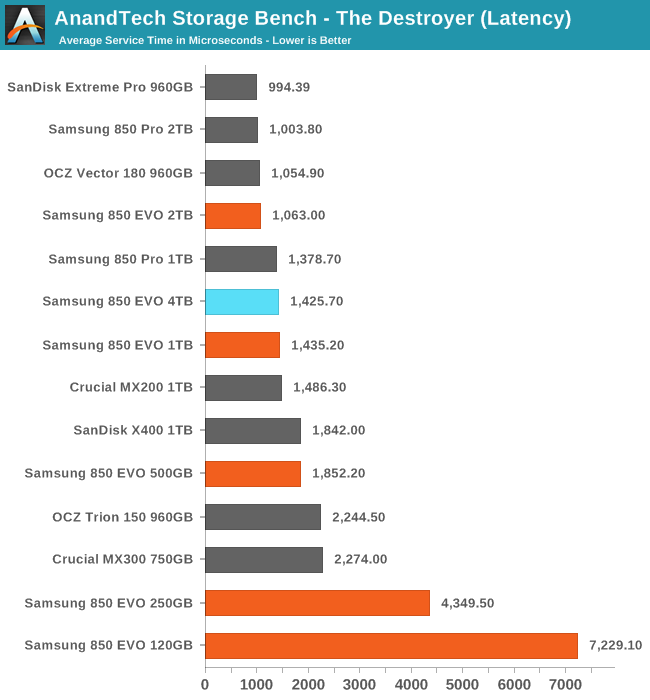
After the 2TB 850 Pro and EVO managed to tie with the top tier of drives for average service time, it is a little disappointing to see the 4TB 850 EVO only manages to match the 1TB models, but that's still high-end performance.
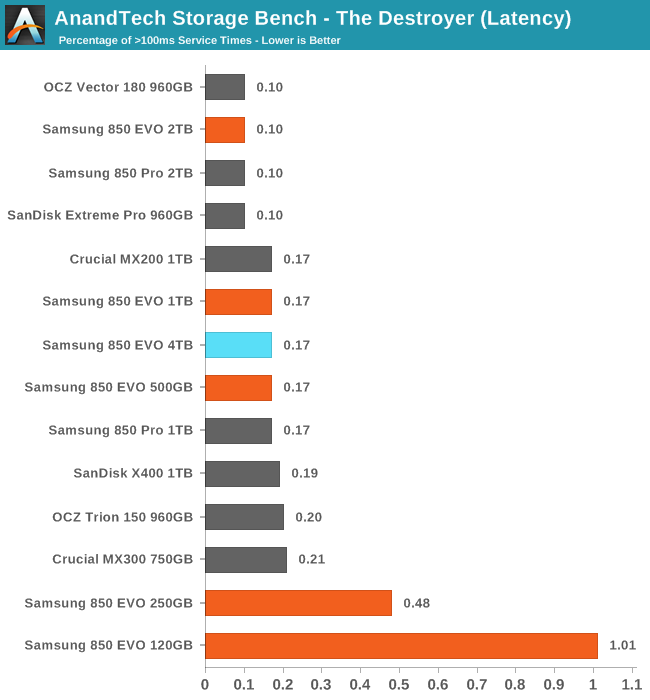
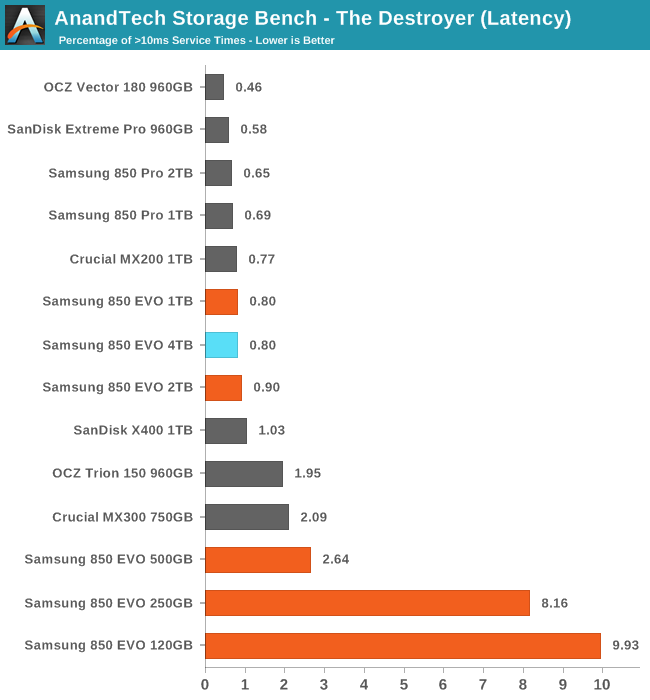
The 4TB 850 EVO has slightly more extreme latency outliers than the 2TB 850s, but at the more strict threshold of 10ms it is tied with the 1TB 850 EVO for being the best TLC drive.
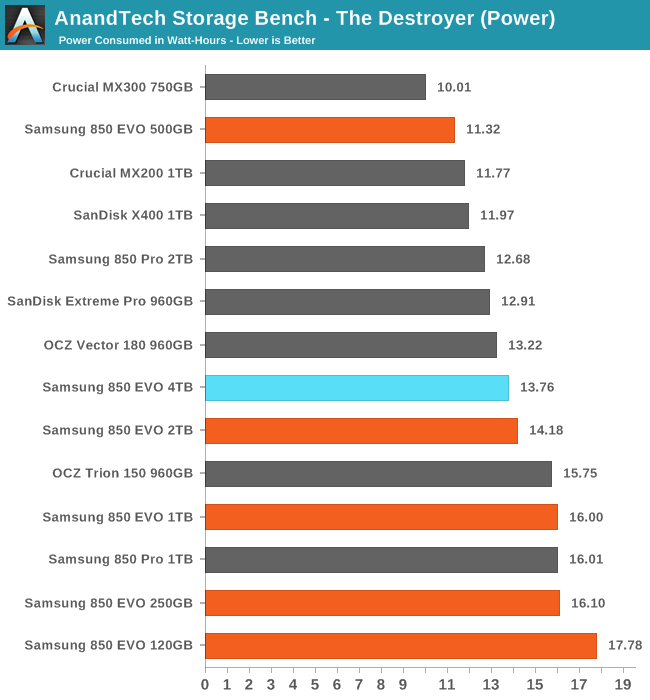
The 4TB 850 EVO brings a little more reduction in power use over the 2TB 850 EVO, which substantially cut power use relative to the 1TB model. The 4TB drive is clearly not paying any significant penalty for keeping so much flash and DRAM powered up.










145 Comments
View All Comments
Enigmatica - Monday, July 11, 2016 - link
Silh is right. My DAW system has 64GB of RAM and all of my samples are stored on a 400GB Intel PCIe NVME drive. I'm only a hobbyist but my set of samples is well into the 200GB range. Pros with all of the gear can easily break 1+ TBddriver - Monday, July 11, 2016 - link
Pros are actually invested in making music than obsessing with sample hoarding ;)NI KOMPLETE is 100 GB and it has pretty much everything you are ever going to need. Naturally, that means actual analog instruments. A lot of mediocre pseudo musicians obsess on hoarding what is not instrument samples but ready to use loops they can play and imagine they are doing music. The format of distribution of that stuff is as stupid as it is itself - since it is not really live performance and usually synthesized sound, it could just as well be distributed as midi + synthesizer presets, and take kilobytes rather than gigabytes - a million times less space...
smilingcrow - Monday, July 11, 2016 - link
Classic “I know what’s best for everybody” rant by someone that fails to understand the topic they are discussing.DPUser - Monday, July 11, 2016 - link
Smilingcrow is right on point here. While ddriver's words may accurately convey the mindset of a certain subset of "musicians" using computers, VI orchestrators and pro producers in many genres are not just using loops; describing these writers, arrangers, performers and engineers as "pseudo musicians" indicates a complete lack comprehension as to how these extremely talented folks work.And while is NI Komplete is wonderful, it is not (yet, if ever) the be all and end all. Incredible VIs are being developed every day by other developers, bringing new levels of fidelity and expression, making greater demands on system real-time performance and soaking up ever-increasing swaths of storage space.
Silh - Monday, July 11, 2016 - link
Have a look at some of the professional orchestral libraries. These are not loops, or instrument runs, but individual note samples, recorded with multiple articulations, velocity layers, different mic positions, etc. You're looking at at 300GB+ for, say, just the strings. VSL's full orchestra comes in about 1TB if you put everything together (and priced waaaaaaaay out of what I can afford).Daniel Egger - Monday, July 11, 2016 - link
RAW Photo editing is harmless: you import all data once and from then on it's mostly reading data. Even if you're a pro you'll have a hard time filling 4x64GB cards a day and you certainly won't sustain that throughout a year. So even if you believed in that segment-my-ass 300TB endurance figure you'll be using it for 3 or 4 years...ddriver - Monday, July 11, 2016 - link
Sure, editing involves mostly reading, you edit the photos then throw away the changes. But even then, photoshop will generate tens of gigabytes of temporary scratch files ;)smilingcrow - Monday, July 11, 2016 - link
A prosumer would be using a separate scratch disk with Photoshop though if they wanted top performance.Impulses - Monday, July 11, 2016 - link
Cheap(er) SATA drives for RAWs here (2x1TB EVO atm), SM951 for the apps and their libraries/scratch.mapesdhs - Wednesday, July 13, 2016 - link
Keep posting your sensible example config, I like that. 8)